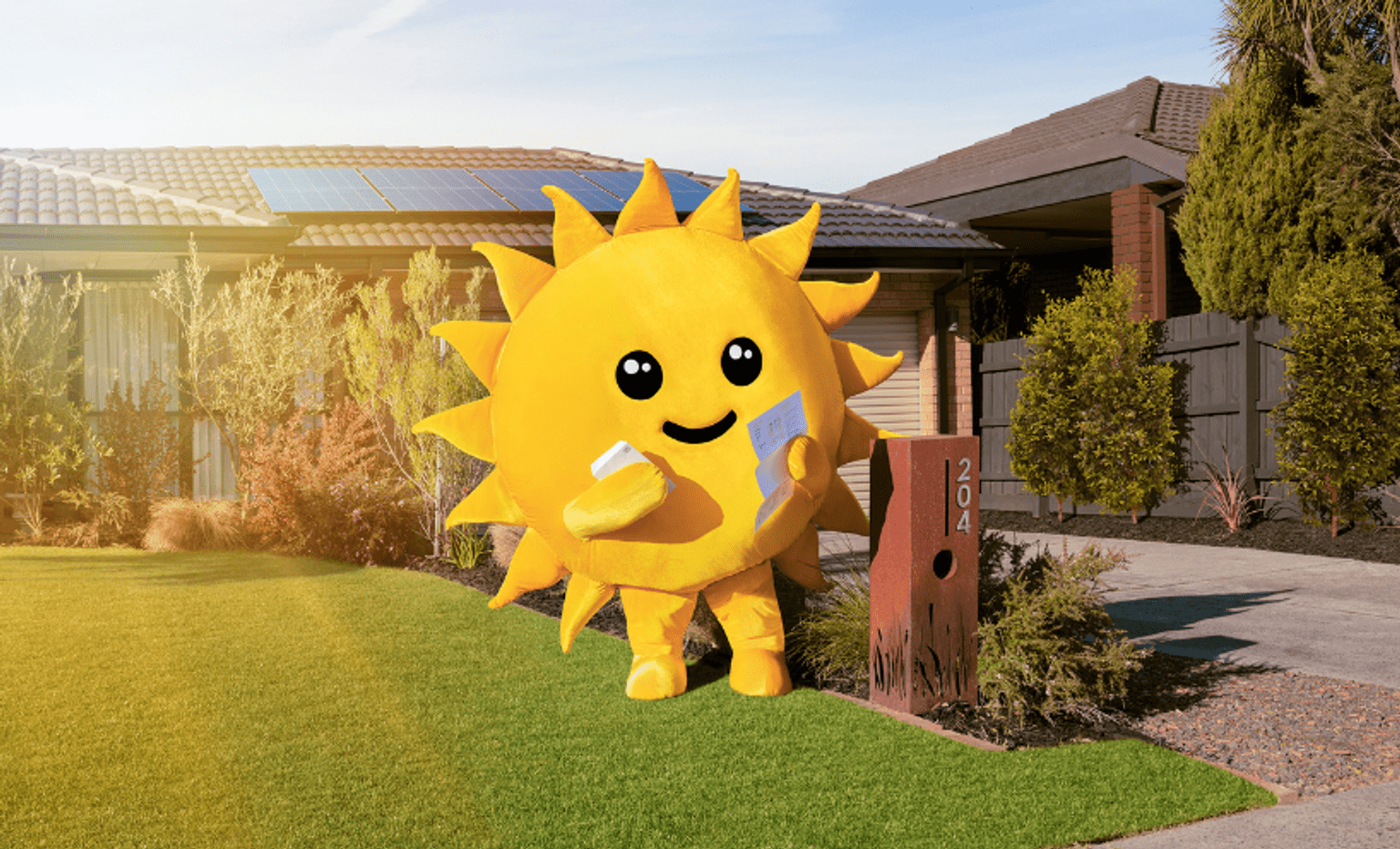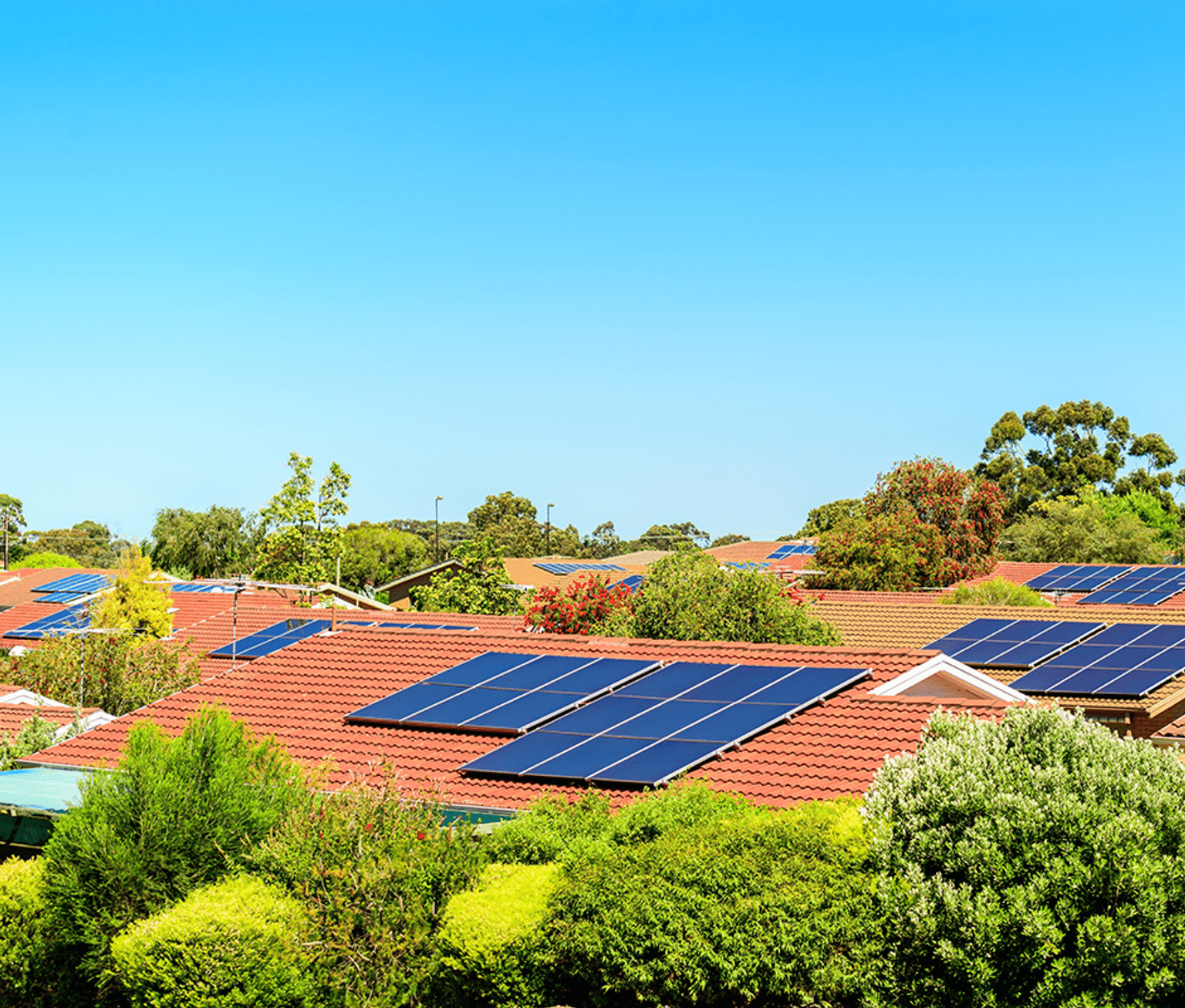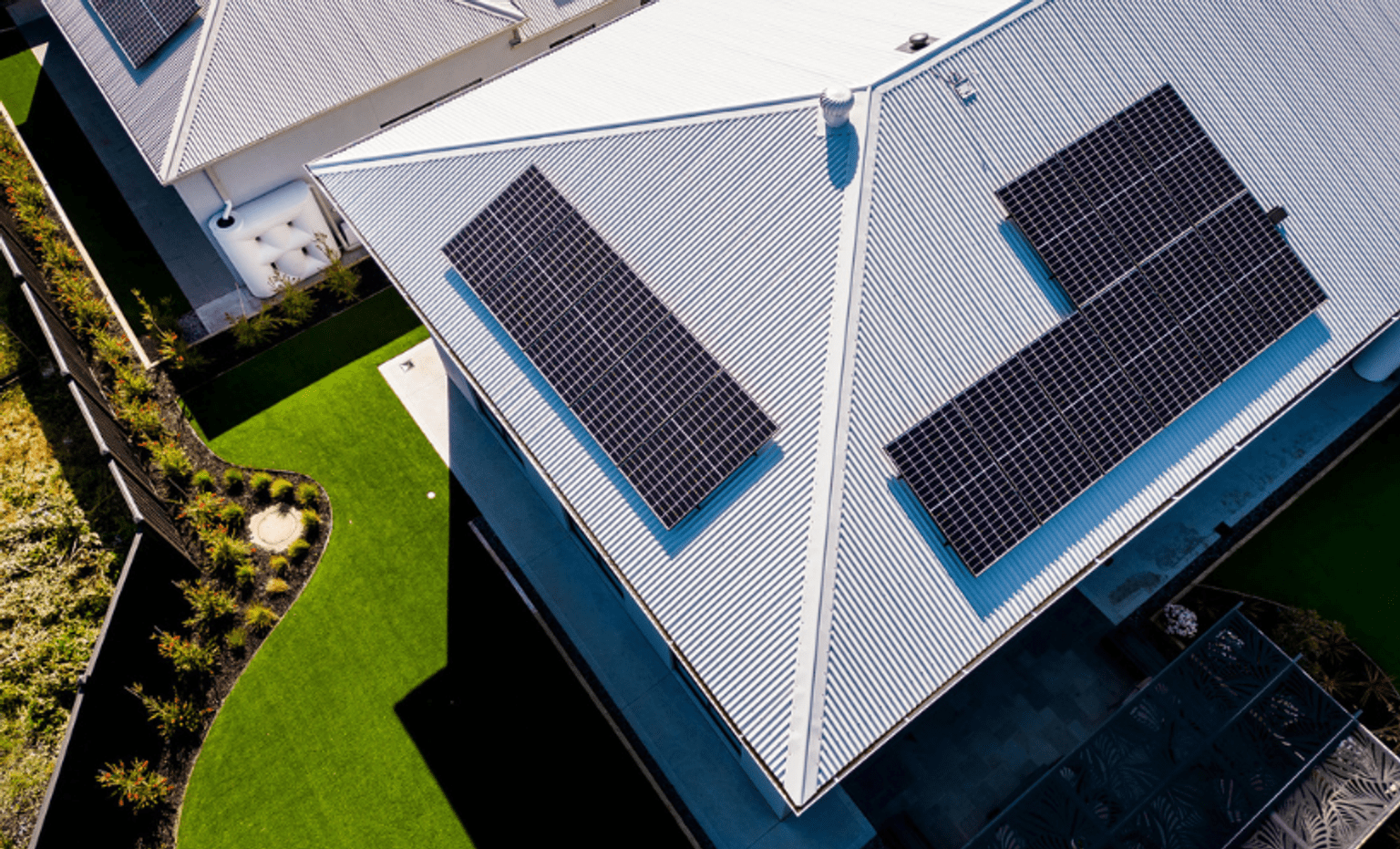- Date:
- 2 Oct 2020
This Buyers Guide includes the types of solar panel (PV) systems available and what to consider when making a purchase. It explains types of panels, what an inverter does, system design considerations, getting connected to the grid, and more.
Read the guide, do your homework and seek out independent advice before contacting retailers for quotes. When you have selected one, see if you are eligible to begin applying for a rebate.
Interest-free loans are also available for solar panel (PV) systems to help further reduce the initial cost.
What to consider before buying a solar panel (PV) system:
Section 1: Why install a solar electricity system at home?
Solar panels have become a common sight on Victoria’s rooftops, helping to lower household energy bills across the state.
Around 15 per cent of homes in Victoria already enjoy the benefits of having a solar PV system installed.
However, there are still many homes missing out on the benefits of a solar electricity system that can take advantage of the Solar Homes rebate to help fund a new system.
Installing solar has financial benefits
Many households want to know if their bill savings will be big enough to justify a solar electricity system.
The clearest answer to this can be found by working out the payback time of a proposed system, which is how long it takes for electricity bill savings to cover the installed system cost, and the annual bill saving, which shows the ongoing financial benefit after the payback period has been reached.
DEECA energy also have Solar Calculator on the Victorian Energy Compare website.
Grid-connected systems should pay for themselves between seven and nine years.
With the Solar PV rebate, a system in Victoria could pay back within three and five years. Today’s grid-connected systems should pay for themselves between seven and nine years in Victoria even without the solar panel rebate, depending on factors such as location, energy retail tariffs and household electricity consumption patterns.
Quality solar panels last at least 25 years, so that initial investment should repay several times over compared with the cost of buying electricity from the grid.1
3-5 year pay back
With a solar PV rebate, a system in Victoria could pay back within three and five years.
Each system installed helps the environment
Many people are focused on the environmental benefits when choosing to install a solar system. Although solar systems still have an environmental impact through the resources required to produce them, such as lithium used in batteries, they create far less of an environmental impact than electricity generated by fossil fuels.
They also do not create any greenhouse gases when generating or storing electricity, helping households to reduce their greenhouse gas emissions and their impact on climate change. As a bonus, any solar generation that a household doesn’t use themselves is sent back to the electricity grid and ultimately used by other households, reducing their environmental impact, too.
Using solar to change your electricity usage
There are several ways you can shift some of your electricity usage to the middle of the day, where you can make much better use of the solar energy you generate. Alternatively, solar batteries can be used to store energy usage above the level produced by solar panels. Energy efficient heat pumps are another way to save on bills, and when combined with solar PV can ‘soak up’ the generated energy through the day and store it in the hot water for your home.
Solar PV checklist: What to consider before buying a system
- Check your eligibility for Solar PV rebate
- Confirm that your system can be connected to the grid
- Learn about solar panel types
- Find out why you need a good inverter
- Do you want a battery system one day?
- Work out how much energy you use
- Think about system size
- Seek out a reputable retailer
- Double check any quotation
- Get a good warranty
1 Calculations are based on a 3kW to 5kW system with no export limits and with a conservative feed-in tariff of 10 cents per kilowatt-hour.
Section 2: What rebates and incentives are available to Victorians for solar electricity systems?
A solar panel (PV) system is a significant investment, with the Solar Panel (PV) Rebate helping to make systems more affordable for Victorians.
Solar Panel (PV) Rebate
Victorian residents can apply for the solar panel rebate to help pay for the cost of a new solar panel system. The solar panel rebate gives Victorian households a discount of up to 50 per cent of the purchase cost to install solar panels, to a maximum of $1,400.
Not-for-profit community housing providers are also eligible to apply for the rebate on behalf of their tenants.
Find out more about the Solar panel (PV) rebate here.
Small-scale Technology Certificates (STCs)
Your new system is also eligible for Small-scale Technology Certificates (STCs). This is effectively a payment made to purchasers of small renewable energy systems for the value of the emissions reduction they create. The quoted price of the system from your installer will have the STC discount included in the final price.
Selling your surplus electricity with Feed-in Tariffs (FiTs)
Any excess electricity generated at home throughout the day can be sold to the grid through your electricity retailer for a feed-in tariff, which is a fixed rate paid to households per kilowatt-hour (kWh) of electricity exported to the grid. Feed-in tariffs vary across states and territories, between retailers, and in some states, even across distribution networks.
Not everyone will be able to feed excess energy into the grid and your local distribution network service provider should inform you if this is the case.
It’s a good idea to investigate whether you will be able to feed excess energy into the grid before buying a system. Your solar retailer should discuss any constraints on exporting energy into the grid with you as part of the quote process.
Victoria has minimum tariffs set every financial year by the Essential Services Commission, and electricity retailers must pay these or higher rates.
Find out more about Victoria’s feed-in tariffs at the Essential Services Commission website.
Compare offers from retailers at Victoria’s Energy Compare website.
Section 3: Grid-connected solar explained
Find out how your new solar electricity system will help your house interact with the electricity grid, drawing electricity when needed and feeding any surplus back intothe grid.
How does grid-connected solar work?
Most solar customers choose a mains grid-connected system for the reliability that such a system offers.
Your home can draw electricity from the grid when insufficient electricity is being generated by the solar panels.
Any electricity produced by the solar electricity system but not needed by your house at the time it is produced is simply fed into the mains grid, with a feed-in tariff paid to the system owner.
Check with your energy distributor that your household will be able to feed excess energy into the grid.
Grid-connected systems have two main components, the solar panel array on the roof, and a grid-interactive inverter, connecting into the household’s switchboard and electricity meter.
Any electricity produced by the solar electricity system but not needed by the house at the time it is produced is simply fed into the mains grid, with a feed-in-tariff paid to the system owner.
Grid Connection
Approval for grid connection from your Distribution Network Service Provider (DNSP).
The DNSP is the business that owns and operates the electricity network – poles and wires – in your area. They are responsible for the physical connection of your system, and house, to the electricity grid.
The process and technical details for grid connection will vary depending on your specific electricity distributor.
Find your electricity distributor on the Electricity Distributor section of Victoria’s Energy website.
Solar Savvy Tip: You should check your eligibility to export with you distributor before you install.
System components: panels and inverter
Solar panels
Solar panels are made from many solar cells connected together, with each solar cell producing DC (direct current) electricity when sunlight hits it. Find out more about solar panels in Finding the right solar panels for your system.
Inverters
A solar inverter is a vital part of a grid-connect solar electricity system as it converts the DC current generated by your solar panels to the 230 volt AC current needed to run your appliances.
A grid-interactive inverter is the most common type of inverter. It requires the mains grid voltage to be present or it will shut down for safety. This means that if there is a power failure, your solar system will shut down and will not supply energy until after the mains grid returns to normal.
Hybrid, or multimode, inverters exist as well, which are designed to work with a battery (if one is installed) and as a grid-interactive inverter as well, allowing you the best of both worlds. Hybrid inverters can feed energy into the grid from either the solar array or the battery bank.
Some hybrid inverters can be installed in such a way that they can isolate themselves from the grid and continue to provide power from solar panels and batteries if the grid is down.
Find out more about inverters in Finding the right inverter for your system.
Below are some of the key issues to consider and discuss with your system installer and distributor.
Metering
Grid connection requires an electricity meter that allows recording of bi-directional electricity flow to measure energy going to and coming from the grid. Most Victorians have Smart Meters, which can do this already. But if you are one of the small number of Victorian households without a Smart Meter, you will need to upgrade.
Speak to your distributor about the process for this, and whether there will be any cost.
What about batteries?
One way of maximising household use of solar electricity is to store it in a battery for use when you need it, rather than when it is generated.
Battery systems have been around for a long time but have been complex and generally too expensive to consider with grid-connect solar PV systems.
That is changing with the introduction of simpler modular battery systems, which means that you can start with just one battery unit and add more if and when needed.
Current battery costs may not make them a suitable investment for every household, though we expect prices to continue to fall over the coming years.
When buying a solar panel system you should consider whether you want to ensure that it is also battery-capable if you want to upgrade.
Find out more about buying a battery in the Battery Buyer’s Guide.
Solar Savvy Tip: We recommend talking to your installer about systems that are battery-capable. This means you will be able to add a battery to your system in the future.
Section 4: Finding the right solar panels for your system
There are no moving parts to wear out in solar panels, just solid-state cells that have very long lifespans. Each cell type and panel have some advantages and disadvantages, though.
Types of solar panels
There are three common types of solar cell:
- monocrystalline
- polycrystalline; and
- thin film.
They are made in different ways and have different performance qualities. If you’re interested in the detail of their different manufacture techniques, performance characteristics, and the pros and cons of each, find out more in Renew magazine’s Solar system buyers guide.
Otherwise,the important thing to know is that regardless of the panel type, the specifications of solar panels show their capacity, price, expected lifespan and other performance characteristics that determine what their energy output will be. These specifications are discussed here.
A larger wattage system will generate more energy in the same installation, but actual energy generation will depend on many factors, such as sunlight hours, clouds, temperature, shading and panel orientation.
Why is panel wattage and size important?
When buying a solar panel system the main specification to be familiar with is the system size in watts. For example, a 3kW system may be made up of twelve 250 watt panels. This watt specification is known as the rated peak power, which is the maximum power generated by the panel under the manufacturer’s test conditions. But what does panel wattage mean for energy generation?
A larger wattage system will generate more energy in the same installation, but actual energy generation will depend on many factors, such as sunlight hours, clouds, temperature, shading and panel orientation. As a rough rule of thumb, find out the average peak sun hours per day in a particular location to get the average energy generation over a year. For example, a 4kW system in Melbourne with average peak sun hours of around 4.6 should theoretically generate around 14.5 kWh of electricity per day, on average, over a year—more on sunny days and less on cloudy days; more in summer and less in winter.
For example, it’s common for solar systems in Victoria to generate more than twice as much in December as July.
Some solar panel manufacturers and retailers have solar output calculators on their websites to help you work out how much energy a proposed system might generate.
When to use larger wattage panels and smaller wattage panels
Using panels with a larger wattage means that fewer panels need to be installed. This simplifies installation, making it faster and cheaper. However, panels of any size can be used for any type of system. For odd-shaped roofs a larger number of smaller panels may enable more generating capacity than fewer larger panels, but the final cost of the installation will most likely be higher.
For more information visit: choice.com.au/home-improvement/energy-saving/solar
Advice on panel quality and selection
Quality counts at the cell level but the overall manufacturing of panels is also crucial. If assembly systems are substandard, some issues can arise that may shorten the life of solar panels or cause increased degradation over time.
One such issue with crystalline cells is that of microcracks—tiny cracks in the cells that can enlarge over time with thermal cycling (as the panels heat up and cool down each day) or with poor handling practices.
Microcracks have the potential to reduce the current generating capacity of any cells affected, and hence the overall output capacity of the panel.
If you have limited roof space, panels with higher efficiency will mean you fit more generation capacity than you could with lower efficiency panels.
Systems with batteries usually have a different inverter. When adding a battery to an existing system, it's not uncommon to replace the inverter.
Section 5: Finding the right inverter for your system
Choosing an inverter may not be the first thing that comes to mind when you’re thinking about installing a solar or solar plus a battery system.
But every one of the two million solar systems already installed in Australia includes an inverter, which can be thought of as the heart of the system—if it’s not working, your solar generation is wasted.
In a nutshell, an inverter takes electricity from a power source that produces ‘DC’ electricity, such as solar panels or a battery system, and converts it into mains-equivalent 230 volt ‘AC’ electricity ready for use in your house.
AC (alternating current) and DC (direct current) are two different forms of electricity. Mains electricity is AC and powerpoints and light fittings put out AC electricity, but many small household appliances convert it to DC before using it.
Why you need a good inverter
It is important to have a good inverter. In grid-connect systems, an inverter failure means your solar panels are doing nothing until the inverter is repaired or replaced. Still, it’s worth remembering that even the best inverter is unlikely to last as long as the rest of your system. Solar panels should last more than 25 years, but inverters are not generally expected to last much more than 10 or 15. You can expect to replace your inverter at least once over the life of your solar PV system.
Which inverter for your needs?
Solar Savvy Tip: If you are going to undersize your inverter, the solar array can be no more than 33% higher capacity than the inverter for the STC rebate to be applied, for example, 6.6kW of solar panels on a 5kW inverter.
Sizing your inverter
In systems using a grid-interactive inverter, the inverter is usually sized to match the solar array. For example, if you have a 5kW solar array, then you would install a 5kW inverter. However, inverters can also be undersized or oversized for different reasons.
Undersizing the inverter (usually referred to as overclocking the inverter or oversizing the solar array) might be done because inverters operate more efficiently when operating near capacity, and solar panels spend most of their time generating below their rated maximum. Solar panels have become cheap enough that the small amount of generation lost when they are running at full capacity with an undersized inverter is usually worth less than the additional cost of a larger inverter – especially when you consider the extra energy captured by the improved efficiency when the panels are generating below their rated capacity.
If you are going to undersize your inverter, the solar array can be no more than 33 per cent higher capacity than the inverter for the STC rebate to be applied, for example, 6.6kW of solar panels on a 5kW inverter.
Oversizing the inverter allows for expansion of the solar array at a later time if desired, and also means the inverter is less stressed at times of maximum generation. The difference in price for a slightly larger inverter may be small in many cases. However in practice, few households add to their solar array after it is installed, and if they do they often finds that changes to standards mean they have to replace the inverter anyway. If you are planning to expand your array in the future, speak with your installer about what might be involved.
Sizing an inverter for a hybrid energy system is a more advanced task that really should be left to the installer, with input from you on power output requirements. There are a number of factors that will determine the hybrid inverter’s ratings, including the size and output capability of the battery bank, the loads the inverter must power, and whether it has to be able to run in UPS mode as a backup power supply when the mains grid fails.
Inverter monitoring and connectivity
All inverters have some way for users to monitor their performance and activity. In its simplest form, this might include coloured indicator lights or text-based or graphical displays that show all the parameters of the inverter, including (depending on the inverter type) battery voltage, current and state of charge; solar array voltage and current; 230 V AC output voltage, current and power, including peak power; and various status and mode displays.
Many inverters have network connectivity using Wi-Fi or ethernet and can upload data to web portals for the owner to see – and share if they want to. Many can connect directly or via the web with smartphone apps that give access to stored and real-time data. Being able to monitor your system remotely is far more useful than having to go outside and look at the display from time to time, so consider this when choosing an inverter. The range of parameters that may be reported and recorded can be vast, including those mentioned above as well as energy consumption of the home, energy exported to the grid or diverted to a specific appliance (such as a hot water system), support energy provided by the battery, battery temperature, inverter temperature, ambient temperature, and any errors that may have occurred.
All this information is useful because it can tell you how well your system is working and show if a problem arises. But some of the information is complex and difficult to interpret without the necessary knowledge or experience. Subscribing to a monitoring service – where a specialist business monitors your system performance and alerts you if something goes wrong – could well be worth the additional cost if it saves you from losing your free energy and feed-in-tariff payments for an extended period of time.
As inverters become more advanced and systems become more complex, the need for inverters to talk to other system components, and even control those components, is growing. Some inverters have these capabilities already, making integrating compatible components, such as grid-interactive inverters into an AC coupled hybrid system, much simpler.
Cost of an inverter
Costs vary significantly by size and quality. As inverters are an essential part of a solar PV system, they are usually included as part of the whole package so their price may not be apparent unless you ask your installer. For a good quality 5kW grid-interactive inverter, expect to pay between $1,000 (for a low-cost but dependable one) and $2,000 (for a premium inverter with extra features).
Hybrid inverters, which also have the capacity to operate from batteries and often contain a high capacity battery charger, are more expensive, with 5kW models costing between $2,500 (budget) and $5,000 (premium).
Approvals and certification
All inverters designed for permanent installation must meet the relevant Australian Standards. Grid-interactive and hybrid inverters and inverter-chargers must also have ESAA (Electricity Supply Authority of Australia) approval before they can be connected to the grid, so check for this also.
It is unlikely that you would find any inverters for sale in Australia without these approvals. However, it is easy to buy inverters and other equipment online from almost anywhere, so if you intend to claim a rebate for your system, the inverter will need to meet all approval requirements.
The Clean Energy Council maintains a list of approved inverters that meet Australian Standards for use in the design and installation of solar photovoltaic (PV) systems.
The Solar Homes program requires the installation of inverters that meet Australian Standards and are IEC 62116 Certified (a safety measure) and have Volt-Watt and Volt-Var response ability (to help manage grid stability in areas where lots of solar PV systems are installed). The specifications sheet for your inverter should have this information, or you can ask your installer. Most inverters on the market meet these requirements.
Section 6: Planning your solar electricity system
There’s a lot to consider when planning a solar electricity system for your home and one factor will influence another.
Household energy use, for example, will determine for instance household energy use will determine what size system you need.
Get the right advice
Remember to seek out independent advice to plan your system. Non-profit organisation Renew offers a range of advice services to anyone looking to invest in energy saving systems for the home.
The Victorian Government also has a range of programs and initiatives to help households plan for their energy needs. Visit the Victorian Energy Saver website for more details.
Work out how much energy you use
Your household electricity use is recorded on electricity bills measured in kilowatt-hours (kWh). Look for a figure that gives average daily usage, and review as many bills as you can to see how this figure varies throughout the year.
Your Smart Meter records your electricity usage every half hour, and this data can give you a much more detailed view of your electricity usage, including how it varies at different times of day and on different days of the week. You can download a spreadsheet of your Smart Meter data from your electricity distributor – however unless you know how to use spreadsheet software (such as Microsoft Excel) to understand what the data can reveal, it may not be useful to you. Fortunately, all the Victorian electricity distributors have online portals that you can log in to and see detailed information about your electricity usage displayed in an easy to understand form.
The distributor is the company that owns the poles and wires in your street and transports the electricity to your home. This is the business you call to report faults and emergencies and is different to your electricity retailers who sends you your bills.
To find out which distribution network you are in, you can look on the back of your electricity bill or go to the Electricity Distributors section of Victoria’s Energy website.
The four Victorian distribution network web portals are:
Energy advice businesses may also use your smart meter data to give you advice about your usage, or to help you plan a solar PV system.
It’s worth also reviewing your gas bills. If your gas use is high then, over time, inefficient gas appliances can be replaced with modern electric ones to make the best use of your solar electricity system, but this means your electricity consumption will be higher.
When planning a solar electricity system for the home it’s useful to know how much energy is used by certain appliances as well. You can use this information to consider replacing older ‘energy guzzling’ appliances, right through to what time of day you might use these appliances, to make the most of the solar electricity generated.
You can use an energy meter such as a PowerMate Lite or Reduction Revolution Plug-in Power Meter to measure the electricity used by certain appliances. Likely problem appliances include old fridges and freezers, older washing machines (especially top loaders if you do warm washes), portable electric heaters such as bar radiators, fan heaters, oil-filled column heaters and panel heaters, older air conditioners, electric hot water systems and pool pumps, which all have more energy efficient alternatives or energy efficient versions on the market now. It’s important to use a good quality energy meter or your readings could be inaccurate, particularly when measuring certain types of loads such as the power supplies in modern electronics.
Examples of household energy culprits and energy use
Halogen downlights are one of the biggest power wasters in the home because they convert nearly all of the energy they use into heat, not light. Replacing 50 watt halogen light bulbs with 10 watt LED bulbs can equate to 80 per cent less energy use for lighting.
This example applies to many appliances in the home and spending a few hundred or even a couple of thousand dollars on more efficient appliances could save you a great deal more than this in energy costs.
As an example, you might monitor your fridge for a week using an energy meter and find that it’s using 4 kWh per day. This is a lot for a domestic fridge, so it might need to be repaired (it might just have damaged door seals or need regassing), cleaned (it might be full of dust at the back) or replaced.
For loads that you can’t monitor directly with an energy meter, such as ceiling lighting and fans, energy use can be worked out with a simple calculation. For example, a 50 watt light used for four hours per day will use 200 watt-hours per day or around 1.4 kWh per week.
Improving energy and thermal efficiency at home
Planning an all-electric home
Some households might plan to switch off their gas supply entirely and go all-electric at home. This saves on gas supply charges and means that more appliances in the home can use solar-generated electricity. An all-electric home benefits if the solar panel (PV) system is sized appropriately to cover most electricity use, although any shortfall can be made up with electricity from the grid. All-electric homeowners pay careful attention to efficiency, including the selection of efficient electric appliances such as reverse-cycle heating and cooling and heat pump hot water systems.
A battery system can further reduce electricity bills by storing excess solar to run electric appliances at night, but before taking this step you should figure out whether the cost of buying and installing the battery, and the foregone feed-in-tariffs, will be lower than the money you will save on bills. If going all electric is something that interests you, visit Renew’s Efficient Electric Homes to find out more.
Working out the right-sized system for your home
This is where you take all the household energy use information gathered, as well as any plans you have to go all-electric to work out what size system suits your needs.
Shading can impact the performance of your panels. It is important to work with your installer to design a system where shading has minimal impact.
Siting considerations
The company you engage for your solar purchase should do an on-site analysis to ensure your site is suitable for solar panels. The following advice will help you get the most out of your solar installation.
Section 7: Finding the right installer and steps to installation
A good installer can help you plan a system for your home that’s sized for your needs and positioned to generate as much electricity as possible to lower your bills.
Steps to purchase, install and connect a solar PV system at home
Keep in mind the following steps to installing a solar PV system at home.
- Read this Buyers Guide to learn about solar electricity systems.
- Confirm your own household’s requirements – see the section on Planning your solar electricity system.
- Seek recommendations on installers or companies that manage installation, and then contact those who are appropriately accredited for quotes.
- Select your preferred installer.
- Make sure the quote meets your needs, using our checklist can help.
- Confirm that your system can be connected to the grid
- Apply for the solar panel (PV) rebate.
- Install your new system
- Connect to the grid, arranged by your installer.
- Enjoy your new system and reduced energy bills.
Finding a retailer or installer
As with all major purchases, you should carefully consider both price and quality when buying a solar PV system.
Solar Savvy Tip: Always get at least three quotes from New Energy Tech Approved Sellers for the same size system. Note that a quality system offering a long and useful life may cost more and be more worthwhile.
New Energy Tech Approved Sellers
Solar PV and battery retailers in the Solar Homes Program must fulfil our requirements, including being a New Energy Tech (NET) Approved Seller.
This means they have committed to high standards across sales and marketing, quotes and contracts, delivery and installation, and warranties and support. Customers doing business with a NET Approved Seller can be confident they are getting clear, honest information, quality installation, and good warranties.
Check the NETCC website for a list of NET Approved Sellers in your area and our list of authorised retailers to see if they are participating in our program.
Accredited installers
The person who installs your system also needs to be accredited under the Small-scale Renewable Energy Scheme with Solar Accreditation Australia, and must hold an unrestricted Class A Electrical Licence registered with Energy Safe Victoria.
A good installer will help you plan the right system to suit your household now and into the future. They will recommend the best position to install your system to generate as much electricity as possible.
How to be sure of quality?
You can be more confident in a solar retailer or installer if they provide you with a written quote and undertake a detailed generation analysis onsite, as part of a free ‘no-obligation’ quote. You should ask about the maintenance and operation requirements of your system, and don’t be rushed into making a decision.
You could also search for a potential retailer or installer online to see if there are complaints from other consumers, or ask for references.
Consider how system faults will be handled
A warranty is only as good as the company that provides it. If the company disappears in a few years, you might have difficulty making a warranty claim should failures occur. It’s not possible to know the future of any solar panel manufacturer or installer, as some of the biggest players over the years have simply disappeared. Seeking out a retailer or installer with a long history in the business helps.
Also, be aware that under Australian Consumer Law, warranties are required to be honoured by product manufacturers even if retailers have gone out of business, so make sure you receive and keep information about the manufacturers of all the different components of your system, and the different warranties on each component.
Consumers have specific rights under the Australian Consumer Law (ACL), regardless of any other warranty provided by the supplier or manufacturer. For more information about your rights visit the Consumer Affairs Victoria website.
What not to do when engaging an installer or company
Installing a solar PV system is something that you want to get right: after all, you only get one shot at the rebate, and a well-installed system with quality parts can continue to save you money for many years to come. A poorly-installed system or one with cheap components can be nothing but trouble.
Don’t buy a solar panel (PV) system from a door-to-door salesperson, or from a salesperson who cold calls you on the phone. If you have signed a contract in this way, take advantage of the 10-day cooling off period under consumer law to cancel the contract, and then take your time to do your homework, plan your system and find a quality installer.
Do not make any payment to a solar provider until your eligibility has been confirmed by Solar Victoria. Apply for eligibility on the Solar panel (PV) rebate page.
Solar Scams
Solar scams do exist unfortunately, with offers too good to be true.
If you are the target of a scam, please report it to the Australian Competition and Consumer Commission (ACCC) via the SCAMwatch website or by calling 1300 795 995.
You can visit the ACCC’s SCAMwatch website for more information on protecting yourself from scams.
What to look for in a quotation
There are a number of details to check in any quotation for a new solar PV system.
Installer and quotation checklist
Section 8: What warranties are available?
Any solar panel worth buying will come with a long warranty.
The working life of a solar panel should be in excess of 25 years and many panels come with a 25-year performance warranty. There are several warranty types to consider.
Panel warranty from manufacturer
Most panel warranties have two parts—a construction/materials warranty and a power output warranty. The first covers the actual manufacturing quality of the panel and warrants the panels to be free of manufacturing and materials defects for a given time, usually 10 years or so, but some manufacturers provide manufacturing warranties up to 25 years or more.
The performance warranty covers the actual panel power output, and is given in the form of a percentage after a certain number of years. For example, a power output warranty might state that a panel will still produce 90% of its rated output after 10 years and 80% after 25 years. Or it might be stated as a linear warranty with just one figure, say 85% after 25 years.
Any high-quality panel would be expected to still produce at least 80% of its original rating after 25 years. Under Australian consumer law importers are responsible for manufacturers’ warranties, so it’s important to know who your importer is because sending the panels back to the country of manufacture would be impractical.
To guard against this issue some manufacturers provide prepaid insurance at no extra cost, which ensures the warranty will be honoured even if the manufacturer goes out of business. Others provide comprehensive insurance, at an extra cost, which covers just about everything from theft to failure for a period of a few years.
WARNING: Remember to read the fine print on all insurance policies, including excesses. If the manufacturer pays for their product insurance annually, rather than it being prepaid in full, the insurance may lapse after the company becomes insolvent, meaning you can lose both warranty and insurance coverage.
Inverter warranty
A good quality inverter should last at least 10 years, if installed properly, and given no accidents such as lightning strikes. Lifespan will vary, depending on a number of factors including ambient temperature, mains grid voltage and mains power quality. Many large electrical spikes, caused by large loads like electric motors, can eventually cause damage to even the best equipment.
Other factors that can affect lifespan are dust, heat, ventilation and pests or vermin such as mice or ants. To guard against the cost of an early failure look for long inverter warranties. Five years is a suggested minimum. A five-year warranty with the option of buying an extra five-year warranty is often available and can be good value and offer peace of mind.
Installation warranty
Another important aspect of the warranties is the installation or workmanship warranty. This is the part of the warranty that is the responsibility of the system installer and covers their workmanship as opposed to the panels or inverters within the system. It is also important to understand whether the installer or solar retailer will assist in enacting any manufacturer warranties should a fault occur with a major system component.
Remember to read the fine print on all insurances policies including excesses. If the manufacturer pays for their product insurance annually, rather than it being prepaid in full, the insurance may lase after the company becomes insolvent, meaning you can lose both warranty and insurance coverage.
Section 9: Consumer protections when buying a solar panel (PV) system
If you have a problem with a solar panel (PV) system installed at your home, you have rights to protect you as a consumer.
You have rights to protect you as a consumer if you have a problem with a solar panel (PV) system installed at your home. This includes the rights you have under Australian Consumer Law and additional entitlements under the New Energy Tech Consumer Code (NETCC).
Retailers in the Solar Homes Program must follow the Code when doing business. It requires them to commit to high standards across sales and marketing, quotes and contracts, delivery and installation, and warranties and support.
Your consumer rights
Australian Consumer Law has rules for responsible marketing and selling, products being fit for purpose, and warranties being honoured. The New Energy Tech Consumer Code (NETCC) has higher standards in these areas. It also has requirements for New Energy Tech Approved Sellers with regard to dealing with problems and complaints.
When you buy a system find out who you should contact if there is a fault, and be aware of the warranties available with your system.
If you have a problem with a product, service or unfulfilled contract try to resolve it directly with your retailer first. Putting your complaint in writing gives you records of your dealings with it.
If you are unable to contact the business, or you do not receive a satisfactory response within a reasonable time, you could lodge a complaint with Consumer Affairs Victoria, who may be able to assist.
The solar energy page on the Consumer Affairs Victoria website has advice on the next steps, from dealing with a faulty product such as a solar inverter, problems with installation and dealing with insolvent businesses.
You can also choose to take your complaint further by applying to a court or tribunal, such as the Victorian Civil and Administrative Tribunal (VCAT), or seek your own independent legal advice.
More information, including who to contact about your rights as a consumer, see Consumer protection.
Section 10: Ensuring safety in the Solar Homes program
Solar Homes requires the highest standards in safety, which is the responsibility of workers and their employers who must ensure their teams are trained, supervised and equipped to do the job safely.
The Solar Homes program requires the highest standards in safety, which is the responsibility of workers and their employers who must ensure their teams are trained, supervised and equipped to do the job safely.
Only licensed electricians, accredited by the Clean Energy Council are permitted to complete solar installations, with every system checked by a licensed electrical inspector.
Solar Victoria is implementing an independent, risk-based audit program conducted post-installation to check thousands of systems to gauge overall compliance with industry practices.
Post-installation audits assess electrical safety, confirms the equipment installed is what was quoted for, and that the installer was approved by the Clean Energy Council to do the work. It also confirms that the inspection by the Licensed Electrical lnspector was done correctly.
WorkSafe Victoria and Energy Safe Victoria are also conducting inspections at the time of installation with a particular focus on fall protection.
An enforcement committee comprising various regulators (WorkSafe Victoria, Energy Safe Victoria, Consumer Affairs Victoria, Victorian Building Authority) and the Clean Energy Council reviews each matter to determine if further action is needed.
This Buyers Guide was developed in conjunction with Renew.
All photos have been supplied with permission and are subject to copyright. Please contact comms@team.solar.vic.gov.au regarding permissions for
use of content and images.







